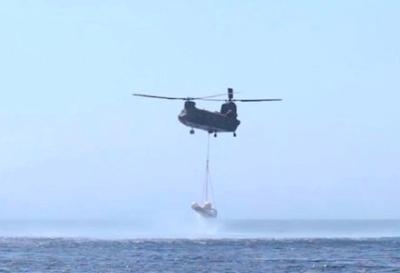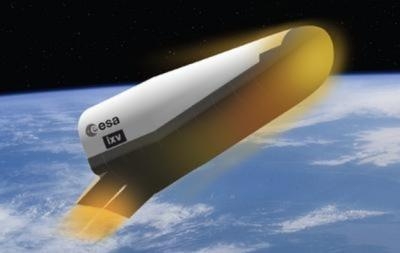Wed, Jun 26, 2013
Released From Nearly 10,000 Feet Off The Coast Of Italy
ESA’s experimental reentry vehicle passed its milestone descent and landing test on last week at the Poligono Interforze Salto di Quirra off the east coast of Sardinia in Italy. The full-scale Intermediate eXperimental Vehicle (IXV) prototype was released from an altitude of 3000 m (about 10,000 feet) by a helicopter, falling to gain speed to mimic a space mission before parachute deployment. The parachute slowed IXV for a safe splashdown in the sea at a speed below 7 m/s (23 f/s). This last step in a series of tests shows that IXV can be recovered safely after its mission into space.

The IXV project is developing and flight-testing the technologies and systems for Europe’s future autonomous atmospheric reentry vehicles. It will be launched by ESA next year on Vega, Europe’s new small launcher, into a suborbital path. It will reenter the atmosphere as if from a low-orbit mission, testing new European reentry technologies during its hypersonic and supersonic flight phases.
Previous campaigns included several water impact tests at CNR–INSEAN, a marine-engineering research institute in Rome, Italy. An instrumented subscale prototype was released at various angles and speeds to assess the best configuration for minimum impact loads.
At the Yuma Proving Ground in AZ, the multistage supersonic parachute was qualified up to the opening of the main subsonic stage. Building on these, Wednesday’s test started with the redeployment of the main subsonic parachute followed by: cutting the two ablative thermal protection covers of the parachute bridles, firing the 16 non-explosive actuators to release the four panels covering the floatation balloons, jettisoning the panels, detecting the water impact, deploying the beacons, and receiving the signal from the Cospas–Sarsat satellite network pinpointing the prototype bobbing in the sea.
An anomaly in inflating the balloons will be investigated. The vehicle was recovered from the sea and taken to land for detailed inspections and analysis.

This test highlights the importance of early inflight verification to secure a robust space vehicle design, confirming the technical direction and possibly suggesting further improvements.
“Our special thanks go to the Italian Defense and the Italian Aerospace Research Centre (CIRA) for the commitment and the excellence exhibited in performing complex air–sea–ground operations enabling the successful challenging descent and landing system test,” noted Giorgio Tumino, IXV Program Manager.
On IXV’s flight next year, the suborbital vehicle will separate from its Vega launcher at an altitude of about 200 miles. IXV will coast to 267 miles and then begin its reentry phase, recording experimental data from a large number of conventional and advanced sensors.
The entry speed of around 4.6 m/sec at an altitude of 74.5 miles will create the same conditions as those for a vehicle returning from low orbit. The mission, lasting more than 2 hours, will end with splashdown in the Pacific Ocean to await recovery and analysis.
(Images provided by ESA)
More News
Aero Linx: Florida Antique Biplane Association "Biplanes.....outrageous fun since 1903." That quote really defines what the Florida Antique Biplane Association (FABA) is all about.>[...]
Beyond Visual Line Of Sight (BVLOS) The operation of a UAS beyond the visual capability of the flight crew members (i.e., remote pilot in command [RPIC], the person manipulating th>[...]
Also: ForeFlight Upgrades, Cicare USA, Vittorazi Engines, EarthX We have a number of late-breaking news highlights from the 2024 Innovation Preview... which was PACKED with real ne>[...]
“For Montaer Aircraft it is a very prudent move to incorporate such reliable institution as Ocala Aviation, with the background of decades in training experience and aviation>[...]
Maximum Authorized Altitude A published altitude representing the maximum usable altitude or flight level for an airspace structure or route segment. It is the highest altitude on >[...]
 ANN's Daily Aero-Linx (04.13.24)
ANN's Daily Aero-Linx (04.13.24) ANN's Daily Aero-Term (04.13.24): Beyond Visual Line Of Sight (BVLOS)
ANN's Daily Aero-Term (04.13.24): Beyond Visual Line Of Sight (BVLOS) Airborne 04.09.24: SnF24!, Piper-DeltaHawk!, Fisher Update, Junkers
Airborne 04.09.24: SnF24!, Piper-DeltaHawk!, Fisher Update, Junkers Aero-News: Quote of the Day (04.14.24)
Aero-News: Quote of the Day (04.14.24) ANN's Daily Aero-Term (04.14.24): Maximum Authorized Altitude
ANN's Daily Aero-Term (04.14.24): Maximum Authorized Altitude




